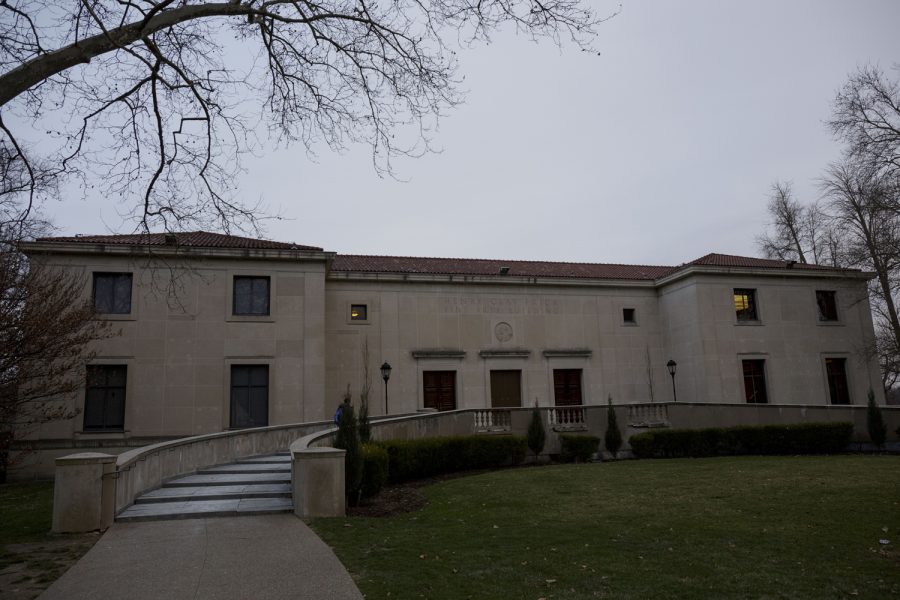Pittsburgh artists reflect on femininity and female bodies in two new exhibits
Thomas Yang | Assistant Visual Editor
The oil paintings of Mary Ethel McAuley, a Pittsburgh journalist and artist, are on display in the Frick Fine Arts building.
February 18, 2020
Lines of oil-painted mothers and children will be marching across the walls of Frick Fine Arts Building for the next month.
The oil paintings were part of an exhibit on Mary Ethel McAuley, a Pittsburgh journalist and artist, and the quilted skirt was part of an accompanying exhibit called Three Artists (Three Women). The exhibits will be on display in the University Art Gallery until March 28.
Sylvia Rhor, the director and curator of the University Arts Gallery, said the exhibits are framed around the idea of forgotten women artists. Rhor told an audience at the opening reception Thursday night the story of Lila Hetzel, a Pittsburgh artist and member of the AAP in the 1900s, who did not want to become a forgotten artist after her death. Rhor said the goal of the exhibits is to highlight the work of a female artist who was forgotten and showcase current female artists.
“We are here to lift up these amazing female artists, and the work they are doing and the work they have done,” Rhor said.
McAuley was a Pittsburgh-based journalist and dispatcher who lived in Germany and wrote about the beginning of World War I. She was also one of the inaugural members of the AAP, a Pittsburgh artist’s collective, in the 1910s. Shown alongside her work are pieces created by the titular Three Artists — Tina Williams Brewer, Frances Gialamas and Sheila Cuellar Shaffer. Brewer is a fiber artist who creates nontraditional quilts with layered textiles, photographs and embellishments, Gialamas is a photographer and painter who portrays industrial remnants in Pittsburgh, and Shaffer is a painter who depicts female bodies and imaginary landscapes.
McAuley’s paintings, which are almost exclusively of women and children, illustrate the lives of the people she encountered in Germany during World War I. The paintings are intended to accompany a book McAuley wrote called “Germany in Wartime: What an American Girl Saw and Heard.” She painted depictions of everyday life behind the frontlines and heavily featured women working and mothering.
Shaffer, a featured artist in the Three Artists (Three Women) exhibit, paints similar subjects of female bodies and feminine scenes. Shaffer said her work is intended to highlight maternal figures and female bodies in society.
“My work is so influenced by women, by the generations of women in my family,” Shaffer said, “it’s an honor to work with and be exhibited with these women.”
According to Madeline Gent, the executive director of AAP, there is a national push by museum curators and artists for exhibits of women’s art, especially at this time of year. Gent said that because Feb. 19 marks the 100-year anniversary of women’s suffrage and because March is Women’s History month, museums and galleries around the country are beginning to focus on art by forgotten women.
“Here in Pittsburgh, and within AAP, we have enough female artists that we could do this exhibit 100 times, with 100 different artists,” Gent said.
The artists in the Three Artists (Three Women) exhibit engage closely with the themes of motherhood and femininity reflected in McAuley’s work. Brewer, a featured artist who works with textile and fiber arts, focuses heavily on the symbolism of family, women and spirituality. Brewer makes textiles using traditional quilting and embroidery methods with nontraditional materials, like photographs and crystal beads. Karen Kaighin, a friend of Brewers, said that Brewers’ art is a way of keeping personal history.
“We’re all trying to keep history, that’s what [McAuley] was doing with WWI and Berlin,” Kaighin said, “but Tina is keeping their life, pictures of a life, and it does remind me of women’s lives.”
According to Rhor, the exhibit came together because of Tasso Spanos, who has owned the collection of McAuley’s work since buying the artist’s paintings in 1971, a few months before she died. Spanos said he talked to McAuley on the phone that year and she asked him to ensure her paintings would be featured in an exhibit in Pittsburgh.
“I was lucky to talk to her, one time, before she died,” Spanos said, “I had bought them in New York, and she wanted me to get her work shown in Pittsburgh.”
Though a few of the paintings have been shown before at the Westmoreland Museum of Art, the John Hermann Museum and the Carnegie Museum, this is the first time all of McAuley’s work has been exhibited together. According to Spanos, the paintings were meant to be seen together with her book. He said that they appeal to all onlookers, not just artists.
“Look at them — there is a universal appeal to them, when you look at them,” Spanos said, “Museum curators love them, but so do children. You can see them, it’s easy to understand.”
The pieces have been restored for the exhibit, revealing new details. Spanos said that prior to restoration, it was impossible to see a chimney or icicles in a featured painting which depict women filling baby carriages with coal from a train. Before being exhibited, McAuley’s work was sitting in an attic. When the Spanos’ moved to Ohio, a friend of his, Joann Lindstrom, stored the paintings in her attic.
“I felt like Jo, from Little Women,” said Lindstrom, “I would go up to my attic, and there were these paintings all over, and I was just drawn to them. I would find excuses to sit up there.”
At the center of the gallery, a massive yellow and red skirt, sewn and embroidered by Brewer, hung over a display. Kaighin said that, to her, the skirt resembled an apron — large and feminine.
“It must be a skirt for a goddess,” Kaighin said, “it is so maternal, so female.”








